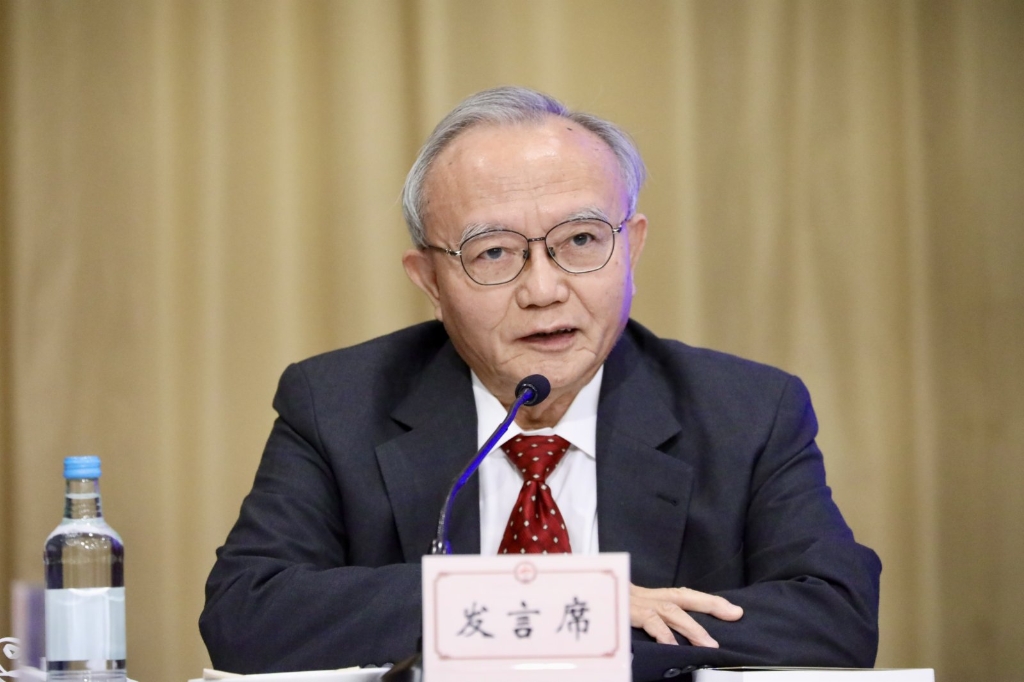By Lau Siu-kai
Over the past two decades, especially after the global financial tsunami in 2008, the process of renminbi internationalization launched by China has picked up speed. Many American politicians and experts believe that the strategic goal of RMB internationalization is to “dethrone” the dollar as the world’s primary international currency. Nevertheless, they at the same time arrogantly and nonchalantly assert that China’s move will fail, citing that the RMB is not yet freely convertible, China’s financial system is not sound, China still imposes draconian capital control, China’s financial system lacks breadth and depth, the RMB exchange rate is mainly determined by the government rather than the result of market decisions, China is unable to provide enough RMB needed by other countries, China provides insufficient protection for private property, etc.
However, China has never stated that it wants the RMB to replace the dollar as the primary international currency and to bear the concomitant responsibilities and costs. The United States provides the world an unlimited amount of dollars through enormous trade deficits, fiscal deficits, staggering debts, extremely high military expenditures, waging wars abroad and simply printing money. China, on the contrary, will not follow the US example. Instead, it hopes to see a diversified international currency system wherein the RMB is a major component. China — as the world’s second-largest economy, “the factory of the world” and the world’s largest trading nation — believes that the RMB should enjoy an international status commensurate with the country’s economic strength. The main goal of RMB internationalization is to promote international currency diversification.
Another purpose of RMB internationalization is to unite countries around the world that have “suffered from the US for a long time” to weaken the dollar hegemony and prevent the US from using the dollar and the dollar-dominated international financial system as weapons to suppress, persecute, coerce, “punish” and harm other countries. After the outbreak of the Russia-Ukraine conflict, the US and its allies imposed numerous “extreme” financial sanctions on Russia, especially in immobilizing Russia’s central-bank assets, creating an international task force to hunt down and freeze Russian assets around the world, and removing key Russian financial institutions from the global SWIFT messaging system. The irresponsible monetary and fiscal policies that the US has been pursuing for a long time and executed at the expense of other countries (including its allies) have not only repeatedly led to financial crises in the US, but also, because of their spillover effects, brought financial and economic calamity to the world. RMB internationalization could reduce China’s dependence on the dollar and can also erode the US’ ability to impose financial sanctions on China, thereby achieving the purpose of “de-weaponization of the dollar” to a certain extent. Since the global political and military hegemony of the US is based on the hegemony of the dollar, de-weaponization of the dollar will help diminish the US’ hegemony. There is no need to destroy the primacy of the dollar in the international arena, and it is impossible to do so, but the US must be prevented from using the dollar as a “killer weapon” to attack other countries arbitrarily.
The main goal of renminbi internationalization is to promote international currency diversification. Another purpose of RMB internationalization is to unite countries around the world that have “suffered from the US for a long time” to weaken the dollar hegemony and prevent the US from using the dollar and the dollar-dominated international financial system as weapons to suppress, persecute, coerce, “punish” and harm other countries
The unrelenting and nonstop “weaponization of the dollar” by the US has aroused resentment and concern from other countries, including its allies. Over the past period, some other countries have adopted piecemeal and intermittent methods to avoid or reduce their dependence on the US dollar. However, these “small actions” have had only a limited impact on the hegemony of dollar.
China’s entry into the “de-dollarization” process will be a game changer. The intensifying US actions in containing and harming China in recent years have forced China to accelerate the pace of RMB internalization and de-weaponization of the dollar. As a huge economy, China’s determination and ability to challenge the hegemony of the dollar are obvious and unquestionable, and its effectiveness in weakening the hegemony of the dollar will grow by the day. The financial means and behaviors encompassed in RMB internationalization are manifold, and its essence is to increase the global supply and use of the RMB. They include: Prudently and continuously opening the capital account; increasing the supply of Chinese Treasury bonds and various RMB investment products and means of hedging; establishing offshore RMB financial centers, with Hong Kong as the premier one; conducting currency swaps with more and more countries, providing the RMB to other countries in need; trading with other countries, especially in energy trade, with the RMB and currencies other than the dollar; introducing the digital RMB; expanding the scope of the Cross-border Interbank Payment System (CIPS), increasing gold reserves, and continuing to reduce its holdings of US Treasury bonds.
China’s continuous reduction of its holdings of US Treasury bonds is critical to the effectiveness of de-weaponization of the dollar because the US is addicted to infinitely issuing Treasury bonds to maintain low-interest rates, high consumption, and huge military spending. Yuan Dong, a Chinese mainland scholar, reasons, “Is ‘US debt’ the weakest link? Of course! The US has long been unable to support its huge national debt and must rely on other countries to buy and hold its Treasury bonds. However, whether they buy and hold US Treasury bonds is beyond the control of the US, and it must depend on the wishes of the other countries. China has become the country with the largest trade surplus and the biggest foreign exchange reserves, and its attitude and actions toward the US Treasury bonds have hence become crucial. Today, when China’s struggle against US hegemony has become extremely clear and direct, it is not only impossible for China to increase its holdings of US debt, but it should instead reduce its holdings. This will be a major and accurate blow to the dollar.” Indeed, China has reduced its holdings of US Treasury bonds over the years. China’s holdings of US debt reached an all-time high of $1.32 trillion in November 2013. As of February 2023, compared with the peak in 2013, China had slashed its holdings of US debt to $848.8 billion, and this reduction is still ongoing.
Of course, China’s actions on RMB internationalization and de-weaponization of the dollar alone are not enough to erode the hegemony of the dollar, at least in the short run. However, being a huge economy similar in size to that of the US, China’s actions will have a major impact on the hegemony of the dollar. China’s efforts on de-weaponization of the dollar will encourage other countries that have long resented the dollar hegemony and weaponization of the dollar by the US to follow suit. At the same time, China is also capable of providing moral and substantive support to them, thereby enhancing their ability to challenge the hegemony of the dollar, safeguard their interests, and avoid US retaliation. For example, China can provide dollars to countries with emergency needs for the dollar, and these countries can then sell natural resources or agricultural products to China in exchange for RMB and repay their debts to China in RMB. In terms of de-weaponization of the dollar, China and other countries will be able to form an indestructible force, and their power to weaken the hegemony of the dollar must not be underestimated.
Recently, in addition to China’s own efforts in de-weaponization of the dollar, China and other countries have continuously strengthened cooperation. Other countries have also taken measures unilaterally or in cooperation to reduce their dependence on the dollar and increase the use of the RMB. Some examples include: Russia’s trade with China is increasingly conducted in their own currencies; Saudi Arabia has contemplated selling some of its oil in currencies other than the dollar; Brazil and China reached an agreement to use their own currencies for trade; Argentina announced the use of the RMB to settle imports from China, and Argentina and Brazil will work on creating a common currency; the Association of Southeast Asian Nations agreed to strengthen the use of the currencies of its member states and launch a domestic payment system; and Bangladesh and Russia agreed to use the RMB to pay for nuclear power plant projects. Of particular importance is the fact that energy trade between countries will increasingly be conducted in RMB, thus undermining the foundation of the petrodollar. In addition, central banks of various countries are increasing their gold reserves, revealing an increasing lack of confidence in the dollar.
At the same time, there is an acceleration of the building of the financial infrastructure that is needed for de-dollarization. After further expansion, China’s CIPS will provide other countries with an alternative to SWIFT. BRICS is studying the establishment of a BRICS currency and a related payment system. As more countries join BRICS, the economic size of BRICS will substantially surpass that of the G7, its challenge to the hegemony of the dollar and SWIFT will be unsurmountable. Agathe Demarais, in her Backfire: How Sanctions Reshape the World Against US Interests, admits: “The rollout of a BRICS-owned payment system will not happen overnight if it does happen. However, such a mechanism will be a game-changer for global payments, and they will revolve around the US dollar and SWIFT, thereby limiting the scope of US sanctions.” In fact, China and other countries’ de-dollarization actions have already achieved initial results. Private foreign investment into US assets has slumped.
While China and other countries are effecting de-dollarization and de-weaponization of the dollar, the financial crisis in the US is becoming increasingly serious and intractable. The national debt of the US is getting bigger and bigger, impacting hugely on the credibility of dollar. According to the figures of the US Treasury, the US’ national debt in inflation-adjusted terms was $4.24 trillion in 1945, $3.21 trillion in 1980 and $7.23 trillion in 1990. By October 2022, the figure had climbed to $31 trillion. By 2021, the unfunded liabilities of the US government (Medicare, Social Security, etc.) were estimated to be a staggering $93.1 trillion.
Today, under its dysfunctional political system, the US has lost the ability to reduce debt, increase savings, and cut public spending, especially military spending, and service debt, and the interest payment on its debts has become a heavy burden on the US government. As this situation will deteriorate without end, its huge impact on the hegemony of the dollar is obvious.
In the days ahead, the dollar, the dollar hegemony, US hegemony, and even US military superiority will decline irreversibly. If the US insists on “weaponizing the dollar”, the decline of the dollar’s hegemony will speed up. It can be said with certainty that in the long run, RMB internationalization and de-weaponization of the dollar pursued ardently by China will completely reshape the global currency and financial landscape, greatly weaken the hegemony of the dollar and the US hegemony it undergirds, and bring about a multicurrency world.
The author is a professor emeritus of sociology, the Chinese University of Hong Kong, and a consultant of the Chinese Association of Hong Kong and Macao Studies.
The views do not necessarily reflect those of Bauhinia Magazine.
Source: China Daily
https://res.youuu.com/zjres/2023/6/5/LAj81NwsekxeIMBlEo90ARUMic7b4A7SpCU.jpeg
掃描二維碼分享到手機














